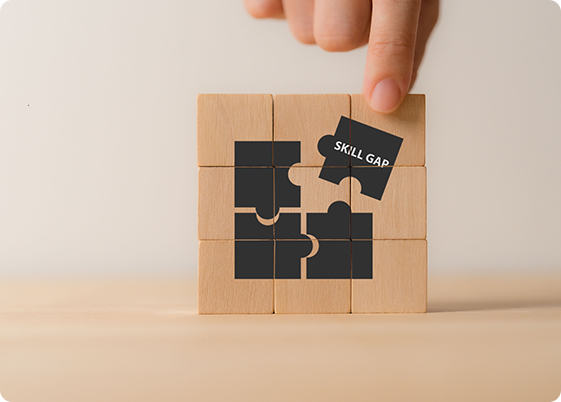
In today’s fast-paced job market, staying competitive requires continuous investment in your growth. That's where a professional development plan comes in. Whether you're looking to get promoted, planning a career transition, or seeking more job satisfaction, having a clear strategy is a key component of successful career planning.
It can help you accelerate your career growth and provide the clarity you need to succeed. This blog discusses why a professional development plan is essential, what it is, and how to design one that supports your career objectives.
What Is a Professional Development Plan?
A professional development plan is a formal, strategic guide that defines your objectives, the skills you must acquire, and the career advancement process. It is a customised guide to help you achieve long-term career goals.
Whether ascending the corporate ladder, creating a career in customer service, or seeking leadership positions, a clear plan can make you stay focused and motivated.
To learn more about transitions and goal setting, check out our guide on how to prepare for a career change.
The Importance of a Professional Development Plan
Knowing the value of a professional development plan can change how you approach your career.
The following are some compelling reasons why every professional needs to have one:
- It makes your career direction and desired goals clear
- It identifies your strengths, weaknesses, and areas for skill improvement
- It ensures your learning efforts are aligned with your career aspirations
- It aids measurable progress through milestones and KPIs
- It promotes continuous growth and adaptability
Whether you’re designing a career growth plan for yourself or a career development plan for employees, the benefits go beyond personal development—they contribute to organisational success and employee engagement.
How to Create a Professional Development Plan
Creating a professional development plan doesn’t have to be overwhelming. Use these steps to create a functional and practical strategy.

Understand Your Current Position
What are your current duties? What are your strengths in your position? Where do you need to improve?
Self-assessment is the starting point for creating an effective career progression plan. Use performance reviews, personality tests, or colleague feedback to get an overall view.
If you’re looking to build a customer service career, knowing where you stand with your service skills and how you communicate is essential.
Set Clear, Specific Goals
Clearly defined goals form the foundation of your career growth plan. They should follow the SMART framework.
Examples:
- Master advanced Excel within three months
- Get a customer service certification within six months
- Get a team lead position in the next year
Set some short-term professional development goals to improve, and consider what you want to achieve in the long run to keep moving forward.

Identify Skill Gaps
Once you have determined your objectives, identify what skills or credentials you need to achieve them. This could involve technical education, soft skills, or even leadership skills.
For example, within a career development plan for employees, HR might determine that communication and working together are the most important skills to develop through the review cycle each year.
Look at job postings from UK platforms for jobs you hope to attain. This can help you identify skills you need to develop.
Build a Network
Professional development does not occur in a vacuum. Working with peers, mentors, and professionals in your field can open doors and broaden your horizons.
Visit industry conferences, participate in LinkedIn groups, and connect with internal stakeholders. Networking is particularly beneficial for identifying new positions or developing a career path planning strategy.

Seek Feedback and Mentorship
Constructive feedback is key to professional development. Request periodic feedback from superiors, colleagues, and mentors. Apply it to hone your style and increase your performance.
Mentors may provide career guidance, discuss their growth experience, and steer you away from common mistakes. In employee career development plan examples, mentorship is frequently referred to as a facilitator of rapid growth.
Stay Adaptable and Open to Change
The working world is constantly changing. Adopt a lifelong learning attitude and be willing to adjust your plan according to new opportunities, feedback, or changes in the industry.
Whether you're following a conventional career progression plan or creating a new path, flexibility is the key to long-term success.
Monitor Your Progress Regularly
Your professional development plan will be successful only if you regularly evaluate your progress. Review your goals regularly—monthly or quarterly—to understand what’s working and what needs adjustment. Quarterly or monthly checks are particularly valuable in a career progression plan for employees since they ensure the proper alignment of staff growth with business objectives.
Use digital notebooks, goal-setting programs, or spreadsheets to track milestones and learning experiences.
When used in a career development plan for employees, frequent tracking of progress also enables annual appraisals and promotion talks.

Work-Life Balance
While career advancement is crucial, it should not be at the expense of your well-being. Add wellness-oriented objectives to your career growth plan, such as coping with stress, enhancing time management, or establishing healthy boundaries.
Merging work goals with private health adds an enduring route to improvement—and makes your success all the more rewarding. It also reinforces the importance of a professional development plan. It ensures that progression is not simply job-oriented, but also equated with broad-based well-being and long-term satisfaction.
Conclusion
A professional development plan is more than a checklist—it's a strategic tool that gives you the power to own your career. Whether new to your field or looking to move into a leadership position, mapping out your path can bring clarity, motivation, and a sense of purpose.
By knowing where you are, setting achievable goals, bridging skill gaps, and being flexible, you can create a fulfilling career that matches your abilities and dreams.
Don’t wait for the opportunity to knock; take control and chart your own path to success. If you are ready for your next step, explore rewarding customer service jobs with HGS UK.
Frequently Asked Questions (FAQs)
What is the purpose of a professional development plan?
A professional development plan helps individuals define career goals, determine areas where skills are lacking, and devise a personal and professional development plan.
What is an example of a professional development plan?
An illustration could be a customer service agent looking to become a team leader by attending a leadership course, completing a six-month mentorship, and applying for a new position.
What are the key components of a professional development plan?
The essential elements are self-assessment, setting goals, identifying skill gaps, ongoing learning, mentorship, networking, and tracking progress.
How do I track my progress in a professional development plan?
You can monitor progress through goal-setting apps, monthly check-ins, performance assessments, and milestone-tracking tools to make ongoing improvements.
 UK
UK Canada
Canada Colombia
Colombia India
India Jamaica
Jamaica Philippines
Philippines US
US SA
SA
